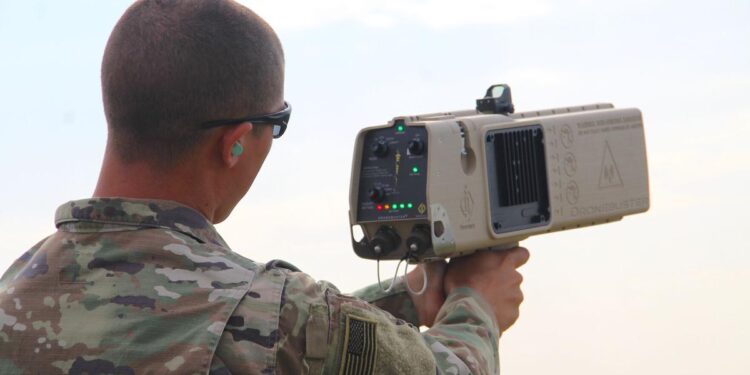Usually, the 3 Battalion, 2nd Air Defense Artillery Regiment at Fort Sill specializes in using large Patriot missile systems for its air defense operations. But due to changing battlefield conditions with the introduction of unmanned aerial vehicles (UAVs), or drones, soldiers need to be prepared for the new threat from the skies.
On Friday morning, soldiers conducted a Counter Small Unmanned Aircraft Systems (C-sUAS) training with the Joint C-sUAS University (JCU) at Fort Sill. Four balloons were attached to one drone, which was then sent flying between 50-80 yards away from the soldiers. The goal: to shoot down all four balloons.
The way the Dronebuster system works is relatively straightforward. The Dronebuster is a compact and lightweight radio frequency jamming device. It is the only handheld electronic attack system for neutralizing UAVs that has been approved by the U.S. Department of Defense. It works by disrupting the control frequency of the drone or even overwhelming its GPS signals. The drone is then forced to either return back to the operator, to land, hover or just fall out of the sky. In order for that to happen, however, the respective soldier needs to aim the Dronebuster directly at the drone.
During the training at Fort Sill, most drones started hovering once being targeted by the Dronebuster, and this opened up opportunities for fellow soldiers to hit the four balloons that were attached to the respective drone, using an M4 carbine rifle with special scope. To make it more difficult, drones were instructed to be on the move constantly.
“It’s a threat that’s increasing on our battlefield, evident by the information we get from Ukraine and the Middle East,” Maj. Kent Tomah said about drones and their impact on modern warfare. “Drones are able to attack and collect information on our troops.”
The Dronebuster system would allow them to “isolate a drone and take it down through kinetic means.”
The Dronebuster system was introduced in 2017. The fight against ISIS, and especially the war in Ukraine, have shown how effective and dangerous drones can be, either as reconnaissance tools to give enemy (or own) positions to the artillery units, or as carriers for explosives, as many videos of small, cheap, commercial Ukrainian drones dropping grenades onto Russian soldiers have shown.
“I think they’ll become much more prevalent,” Pvt. Adam Shoemaker said. “Right now, we are seeing a lot of single or small group drone activities, but it could very potentially become large scale, almost like a swarm. That’s pretty scary to think about. If there’s 50 of them, you need a lot of people to be able to counteract that.”
“What we try to do to replicate the threat that our warfighters are facing,” Jennifer Smith, director of the JCU, said. “We have many different systems at many different capabilities and we will utilize those.”
The training also serves as preparation for the opening of the Counter Small UAS (unmanned aerial systems) university at Fort Sill on Oct. 1.
“Currently, at Yuma Proving Ground (YPG), they have the Counter Small UAS academy,” Smith said. “Headquarters has directed us to take this over. YPG will move her to Fort Sill. We are very excited about it. It’s a joint mission, so you will see Air Force, Marines, Navy and a lot of our allies and partners being here training with us.”
Want to reach a local audience and grow your business?
Our website is the perfect platform to connect with engaged readers in your local area.
Whether you're looking for banner ads, sponsored content, or custom promotions, we can tailor a package to meet your needs.
Contact us today to learn more about advertising opportunities!
CONTACT US NOW






